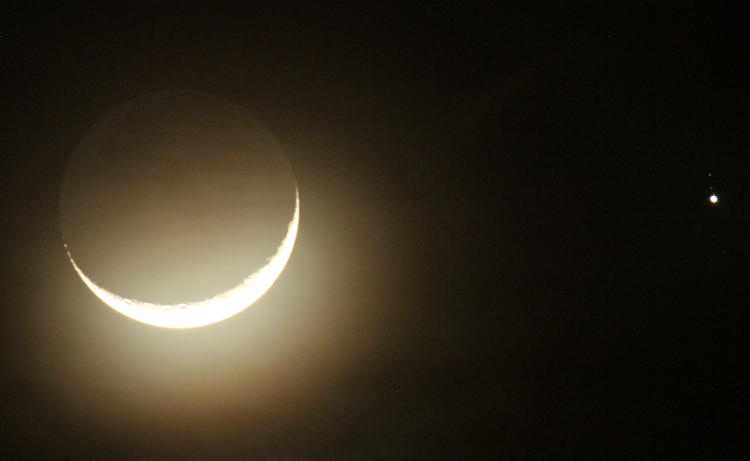
I did manage to set aside a little time to pursue some photos for National Wildlife Day but the wildlife was not cooperating very well at all – mostly what I got were some lackluster photos of solitary cormorants. And the images here are about as far removed from wildlife as possible, definitionally and linearly, but I saw this in the sky and had to grab the tripod to fire off a few frames. I remember hearing about a conjunction coming up but let it slip from my mind, and caught it anyway because I’m just that good. So here’s tonight’s crescent moon, with Jupiter alongside and Venus way off down there in the corner. I had the long lens on and, backing off down to 150mm, I could get all three in the frame. But it looks better concentrating on the closer two.

I was aiming mostly to bring up the earthshine in the shadowed portion of the moon, but also just barely caught the Jovian moons as well – no earthshine on those, admittedly, and there won’t be, because they will never show crescents to us here on Earth. Jupiter is far enough out that the sun is always effectively ‘behind’ us to its orbit, and the only planet (or any major body) that can show phases to us Venus, because it’s closer to the sun than we are. Mercury probably can too, but that’s close enough to the sun that no equipment that I have is going to capture it. Meanwhile, we’ll take a closer look at Jupiter and its entourage.

This is with the 150-600 at 600mm, with the 2X teleconverter as well, so about 1000mm (I know that doesn’t seem to make sense, but calculating the magnifications indicate that the 2X converter isn’t quite 2X – closer to 1.8X,) and this is a full-resolution crop of the frame. The Jovian moons, meaning the largest and easiest to see from Earth, are all visible here: from top, Ganymede, Io, Europa, and way down below trying to hide is Callisto. While checking the details in Stellarium, I noticed that it was showing only three of the moons, and eventually determined that Europa was ‘there’ but not displaying in the program – probably something to do with the version that I just reinstalled.
But yeah, this is as good as it gets until I get the telescope up to speed. So we’ll turn to the moon for a moment.

Part of the glare here is due to the humidity, and I will note that Venus vanished from site before it ever set, and only minutes after I got the frames that included it, above. But most of the glare simply comes from overexposing the moon to bring out detail from the earthshine – not quite the best phase to tackle this within. I should have tried last night if I wanted that, because we’re in the waxing period now and the moon will only be increasing in phase for the next two weeks, becoming brighter and worsening the glare.
BUT, I’m not a total loss, because while out on the edge of the neighborhood pond getting these pics (the best view towards the west,) I noticed a few frogs hanging out, so I include a true bit of wildlife for the day:

This is a common-as-the-muck-it’s-sitting-in green frog (Lithobates clamitans,) and about as token as you can get for ‘wildlife.’ But at least it’s not an insect. Admittedly, I could have snagged an image of one every night that it’s been even slightly warm all winter, because there are three wintering in the backyard pond that pop up with the faintest hint of a decent temperature, but, well…




















































